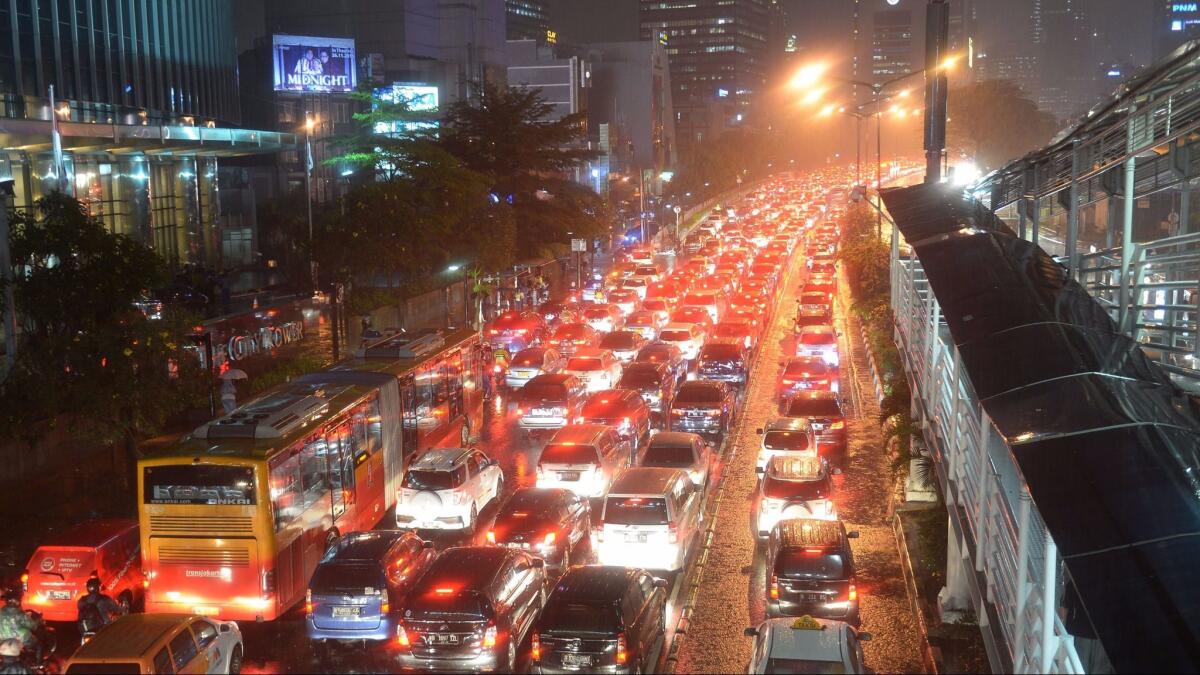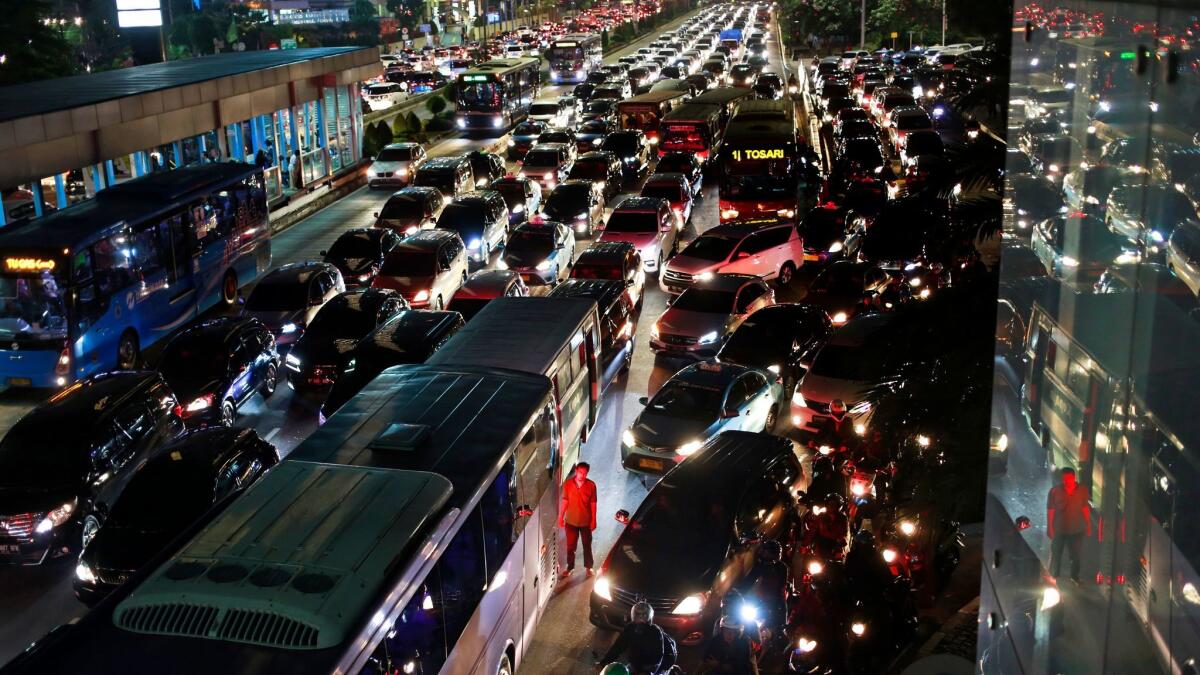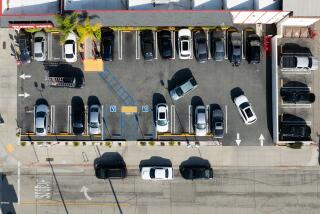Policy change in Jakarta accidentally teaches drivers the value of carpool lanes

- Share via
Los Angeles, if you think traffic on the 101 is bad, be thankful you don’t live in Jakarta — especially since the Indonesian capital did away with its controversial carpool rules.
When vehicles on the main road into Jakarta’s business district were required to have at least three occupants during rush hour, it would take commuters an average of 2.8 minutes to move 1 kilometer between 7 a.m. and 8 p.m. That works out to a pace of about 13 miles per hour. At times of peak congestion, drivers could wait up to 4.4 minutes to move just 1 kilometer. (For the sake of comparison, the average delay on Los Angeles freeways is 0.7 minutes per kilometer, or 53 mph).
Now economists have proof that Jakarta’s carpool policy worked: When it was abruptly canceled, traffic went from dreadful to outright atrocious.
Using Google Maps data collected from Android phones, researchers from Harvard and MIT calculated that commute speeds slowed by 0.98 minutes per kilometer during the mornings and by 2.5 additional minutes per kilometer in the evenings. That translated into a 46% increase in commuting time in the morning and an 87% increase in the evening, according to a report in Friday’s edition of the journal Science.
The end result: Vehicles on the road previously restricted to carpools crept along at 12 mph at the start of the day. On the way home, they didn’t even hit 7 miles per hour.
As MIT economist and study co-author Benjamin Olken put it, that’s “only just a little bit faster than walking.”

Jakarta’s carpooling policy was first introduced in 1992. It required private cars on Jalan Sudirman — a 12-lane thoroughfare in the city that leads to the country’s stock exchange, several government ministries, office buildings, hotels and shopping centers — to have three or more passengers between 7 a.m. and 10 a.m. and again between 4:30 p.m. and 7 p.m. Violations were punished by a maximum fine of 500,000 rupiah (about $37.50).
“The policy was not necessarily popular,” the study authors wrote. Many Indonesians were skeptical the rule was easing traffic, especially since drivers could get around it fairly easily by hiring “jockeys” to ride with them for about a dollar and change. Indeed, there were accusations that some poor families were tranquilizing their babies and renting them out for this purpose in order to make ends meet.
Outrage over the practice reportedly prompted the governor of Jakarta to announce an end to the “three-in-one” carpool policy in March 2016. The change, he said, would go into effect in about a week.
It was a perfect scenario for what economists call a “natural experiment.” Olken and his co-authors, Rema Hanna of Harvard’s Kennedy School of Government and Gabriel Kreindler of MIT, swung into action.
Two days after the new policy was announced, the trio began collecting traffic data from drivers on Jalan Sudirman. They also collected data from drivers on two nearby roads that are used as alternatives to Jalan Sudirman and were never subject to the carpool policy. The Google Maps data was sampled every 10 minutes around the clock for more than a month.
Not only did traffic on the main road get worse after the carpool rule was lifted, it also got worse on the alternative routes in the middle of the day and during the evening rush hour, the researchers found.

This suggests the policy change didn’t prompt drivers who were previously ineligible to use Jalan Sudirman to ditch the side routes and merge onto the main road. If they had, the traffic situation would have improved on the streets that were never subject to the three-in-one rule.
Instead, the simplest explanation for the data was that “there is more traffic overall throughout the city” once carpools were no longer required, according to the study.
The researchers then expanded their analysis to include an additional road that had been reserved for carpools (called Jalan Gatot Subroto) and eight other roads that were not. Once again, traffic got worse not just on the former three-in-one roads but also on the alternative roads, where delays increased 21% at midday, 29% during the evening rush hour and 34% in the hour after.
The economists didn’t seem especially surprised to find that carpool rules reduced traffic. However, they seemed a bit taken aback by the size of the effect, which they said was “quite remarkable and considerably larger” than was documented in Los Angeles (when a 2003 strike by public transit workers added cars to the roads) or London (where drivers must pay a “congestion charge” to drive in the city center between 7 a.m. and 6 p.m.).
It remains to be seen whether drivers in Jakarta will find some way to adjust, such as moving closer to their workplaces or by finding jobs closer to home. Either of those responses should improve traffic flow, but finding a new home or job takes time, and the study period lasted only 4.5 weeks.
According to a commentary by Berkeley economist Michael Anderson, the study authors found that congestion had improved by the end of the summer, several months after the carpool policy changed. But that might have been the result of workers taking summer vacations. It might also reflect the success of a new policy that allows only half of the city’s cars to drive on certain roads during rush hour.
Even so, Anderson wrote, Jakarta’s experience shows drivers in L.A. and the rest of the world that carpooling “can play an important role in the congestion-relief toolkit.”
Follow me on Twitter @LATkarenkaplan and “like” Los Angeles Times Science & Health on Facebook.
MORE IN SCIENCE:
In rural America, opioid prescriptions continue to flow, new CDC report shows
Does my sense of smell make me look fat? In mice, the answer seems to be yes
In a temple that predates the pyramids, scientists find evidence of a mysterious ‘skull cult’







